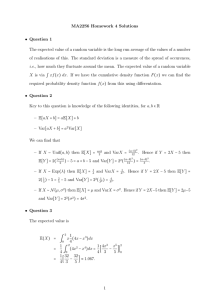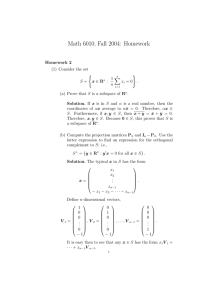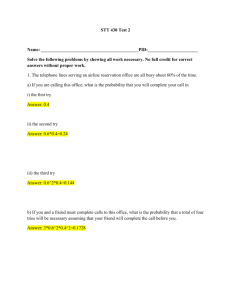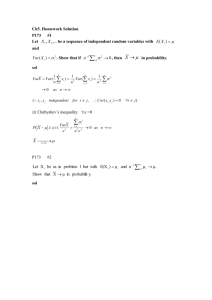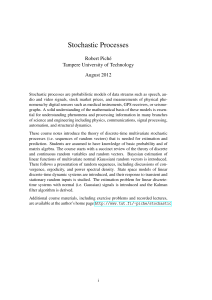STAT542 HW4 SOLUTION 2.25
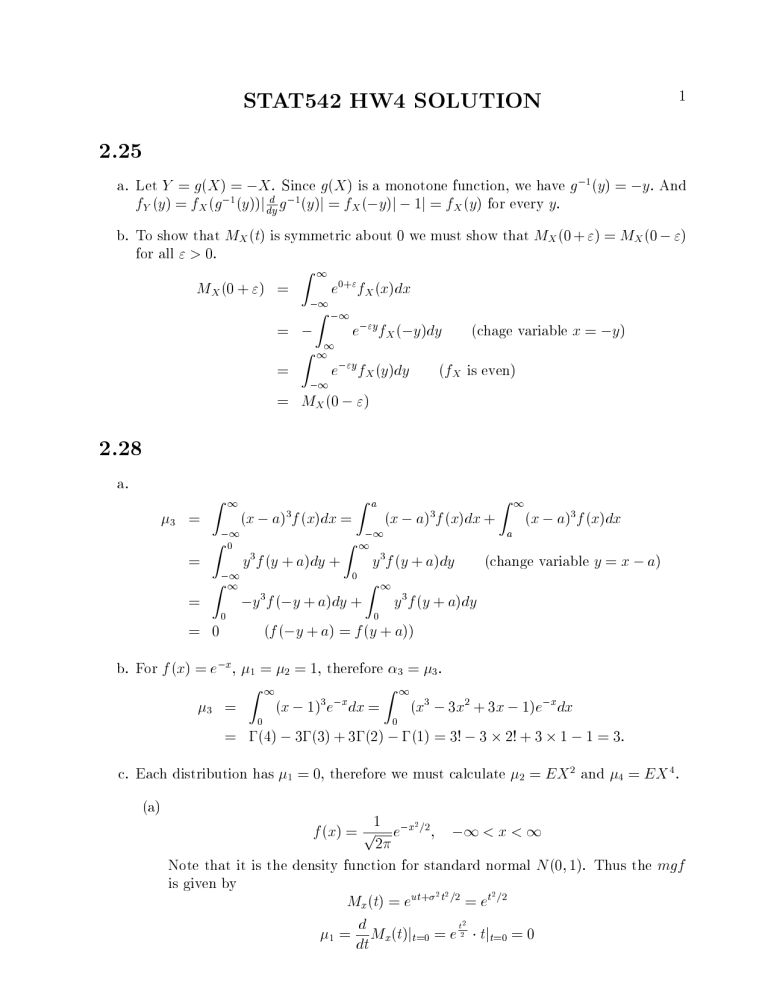
STAT542 HW4 SOLUTION
2.25
a. Let Y = g(X) = X. Since g(X) is a monotone function, we have g f
Y
(y) = f
X
(g 1 (y))j d dy g 1 (y)j = f
X
( y)j 1j = f
X
(y) for every y.
1 (y) = y: And b. To show that M for all " > 0.
X
(t) is symmetric about 0 we must show that M
X
(0 + ") = M
X
(0 ")
Z
1
M
X
(0 + ") = e 0+" f
X
(x)dx
=
1 e "y
=
Z
1
1
= M
X e "y f
X
1
(0 ") f
X
( y)dy
(y)dy (f
X
(chage variable x = y) is even)
1
2.28
a.
3
=
Z
Z
=
Z
=
= 0
0
1
0
1
(x a) 3 y 3 f(x)dx = f(y + a)dy +
Z
1
1 y
Z a
1
(x a) 3 f(x)dx +
1 y 3 f(y + a)dy
3
0 Z
1 f( y + a)dy + y 3 f(y + a)dy
0
(f( y + a) = f(y + a))
Z a
1
(x a) 3 f(x)dx
(change variable y = x a) b. For f(x) = e
3 x ,
1
Z
=
1
2
= 1, therefore
3
Z
1
(x 1) 3
=
3
.
= e x dx = (x 3 3x 2 + 3x 1)e x dx
0 0
= (4) 3 (3) + 3 (2) (1) = 3! 3 2! + 3 1 1 = 3: c. Each distribution has
1
= 0, therefore we must calculate
2
= EX 2 and
4
= EX 4 .
(a) f(x) = p
1
2 e x 2 =2 ; 1 < x < 1
Note that it is the density function for standard normal N(0; 1). Thus the mgf is given by
M x
(t) = e ut+ 2 t 2 =2 = e t 2 =2
1
= d dt
M x
(t)j t=0
= e t2
2
tj t=0
= 0
4
2
= d 2 dt 2
M x
(t)j t=0
= e
3
=
= d dt
4 d 3 dt 3
4
M
M x x
(t)j
(t)j t=0 t=0
= e
= e t2
2
4
= 4
2
= t2
2 t2
2
(t 4
3
1
(t 2
(t 3
+ 6t
= 3
+ 1)j t=0
+ 3t)j t=0
2 + 3)j
= 1
= 0 t=0
= 3
2
(b)
2
4 f(x) =
Z
1
= x 2
1
1
1
2
;
=
Z x 4
1
1
2
1 < x < 1 dx =
1
2 dx = x x
6
3
5
10 j j
1
1
1
1
=
=
4
=
4
2
=
( 1
3
1
5
) 2
=
9
5
1
3
1
5
(c)
2
=
Z
4
=
Z
1
1 x 2
1
2 e
1
1 x 4
1
2 e jxj dx = jxj dx =
1
2
1
2 f(x) =
Z
0
Z
0
1
1
2 e jxj ; x 2 e x dx+
1
2
1 x 4 e x dx+
1
2
4
=
4
2
1 < x < 1
=
Z
1 x 2 e
Z
0
1 x 4 e
0
24
4
= 6 x x dx = dx =
Z
1 x 2 e
Z
0
1 x 4 e
0 x dx = (3) = 2 x dx = (5) = 24
Thus (c) is most peaked, (a) is next, and (b) is least peaked.
2.32
d 2 dt 2 d dt
S(t)j t=0
S(t)j t=0
=
= d dt d dt log[M x
(t)]j t=0
=
M
M x
(t)
(t) j t=0
= d dt
M
M x x
(t)
(t) j t=0
=
EX
M x
(t)M (t) [M
[M x
(t)] 2
1
= EX (since M
(t)] 2 j t=0
=
1 EX 2 x
1
(0) = Ee 0
(EX) 2
= 1)
= VarX.
3.2
Let X = number of defective parts in the sample. Then X is hypergeometric(N = 100; M; K) where M = number of defectives in the lot and K = sample size.
3 a. If there are 6 or more defectives in the lot, then the probability that the lot is accepted
(X = 0) is at most
P (X = 0jN = 100; M = 6; K) =
6
0
94
K
=
100
K
(100 K):::(100 K 5)
100:::95
By trial and error we nd P (X = 0) = 0:10056 for K = 31 and P (X = 0) = :09182 for K = 32. So the sample size must be at least 32.
b. Now P (accept lot) = P (X = 0 or 1), and, for 6 or more defectives, the probability is at most
P (X = 0 or 1jN = 100; M = 6; K) =
6
0
94
K
+
6
1
94
K 1
100
K
100
K
By trial and error we nd P (X = 0 or 1) = :10220 for K = 50 and P (X = 0 or 1) =
:09331 for K = 51. So the sample size must be at least 51.
3.10
a. The ways to choose 4 cocaine packets and then 2 nonconcaine packets are
The ways to choose 4 packets and then 2 more parckets are
N + M
4
Hence
P (defendant is innocent) =
N + M
4
N
4
M
2
N + M
2
4
N
4
M
2
N + M 4
2 b. Note that M = 496 N, then
P
N
=
N + M
4
N
4
M
2
N + M 4
2
=
N
4
496
4
496 N
2
; N = 4; :::; 496
492
2
.
.
Since P
N+1
P
N for large N s
=
0
@
N + 1
0
@
4
N
4 trial and error we nd
1 0
A @
1 0
A @
P
330
496 N
496 N
2
=
2
330
4
496
4
1
A
1
1
A
, the ratio> 1 for small N
. Compute numerically, we could get P
166
2
492
2
N+1
=P
N
= 0:0220809 s
4 and the ratio< 1
= 1 , N 330:33. By
P
331
=
331
4
496
4
165
2
492
2
= 0:0220817
Thus when N = 331, P
N attains its maximum and P
N
= P
331
= 0:0221.
Additional Problems
1
Var[3X(X 1) + 5] = Var[3X(X
= 9(EX 4
1)] = E[3X(X
2EX 3 + EX 2 E 2 X
1)]
2
2 E
+ 2EX
2
2
[(3X(X 1)]
EX E 2 X)
2
E() = E
(X EX)
VarX
=
Var() = Var
(X EX)
VarX
EX EX
VarX
=
VarX
VarX
= 0
= 1
3
M y
(t) = Ee ty = Ee (ax+b)t = Ee atx e bt = e bt Ee atx = e bt M x
(at)
4
M v
M u
(t) =
(t) = e t t
1
;
1
1 t
; t < 1:
Let X p
Varu
= p
12u p
3, Y p
Varv
= v 1. Using the result of equation 3, we have
M
X
(t) = e p
3t
2 p e
3t p
3t
;
5
M
Y
(t) = e t
1 t
; t < 1:
Mu(t)
Mv(t)
Mx(t)
My(t)
−6 −4 −2 0 t
2 4 6
